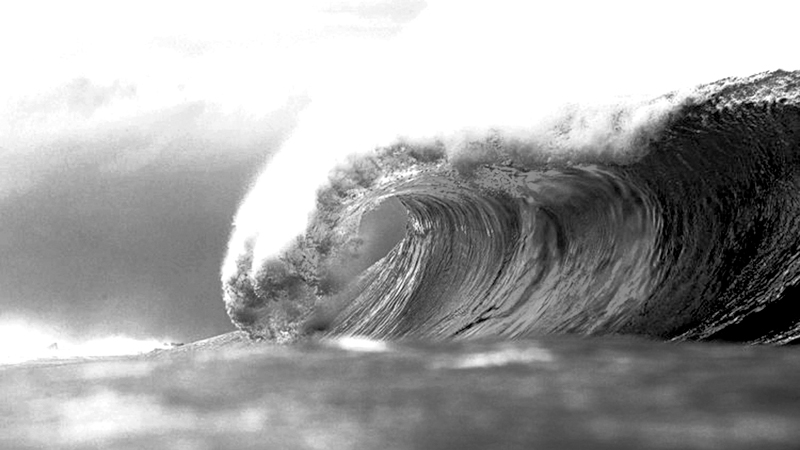Iwas just 11 years old when the tsunami hit Sri Lanka.
A toppled train next to a twisted track, coastal homes crumbling into the sea and a ship anchored at port being tossed around like a little paper boat, this is what we saw on the news.
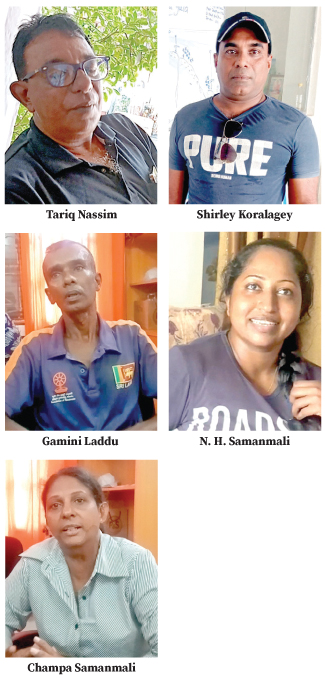 The 2004 tsunami was our nation’s greatest natural disaster. Thousands of lives were lost in just a few hours and the damage to the economy easily set us back a few years.
The 2004 tsunami was our nation’s greatest natural disaster. Thousands of lives were lost in just a few hours and the damage to the economy easily set us back a few years.
Although two decades have passed, there are still traces of this collective trauma. To see how far we have healed, I travelled down the Southern coast to interview a few survivors.
An angry storm
Seenigama is a sleepy town next to its bustling neighbour Hikkaduwa. My guide, Vishmi Kaushalya remembers how the peace was shattered on that fateful December morning. She said she could even at this point of time recall the roaring sounds of the devastating wave. “It sounded like a ferocious, angry storm and the people’s screams took up the chorus and it reached a crescendo. It was pure horror”, Kaushalya said.
Kaushalya works for the Foundation of Goodness, a non-profit organisation dedicated to uplift rural communities. The Foundation, as it is commonly called by the locals, experienced the tsunami at first-hand and worked extensively to reduce the chaos in the aftermath of the disaster.
The tsunami watermark is printed in bright red letters over the doorway leading to the villa. A granite plaque memorialises the eight people who perished on the property.
Muttiah Muralitharan was slated to come to the Foundation for a charity program that day, Champa Samanmali said. Champa has been working for the Foundation for over 25 years.
“I was at the Foundation. I heard a lot of people screaming and I looked out and saw people running hither and thither. I asked one of our neighbours what was happening and she said that the ocean was flowing inland. At first I thought it was funny since it may have been a huge swell from the warakanna season. I was packing stationery for the charity drive so I went inside and met our founder who asked me what was happening outside and I said it’s just a big swell. But when I went outside once again to my horror I saw a huge stampede. People were trying to make good their escape from the waves that were virtually chasing them”, Champa said.
Realising that a disaster was in the making, Champa began to worry about her family. “I ran outside, but once out of the gate I saw this dark-brown wave carrying planks and logs rising like black smoke. I couldn’t run 10 feet when I got caught in the flowing waters. I remember grabbing hold of the Foundation’s outer wall and trying to hold on”.
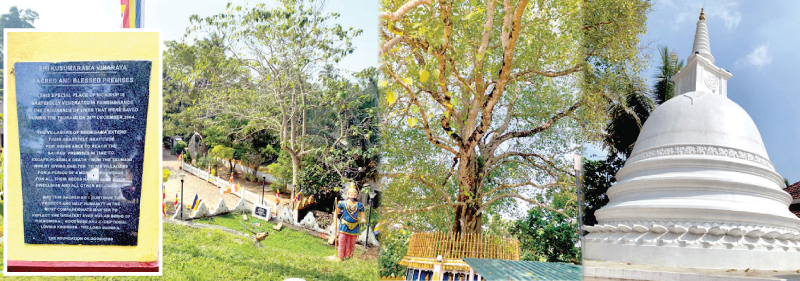
Plaque honouring the Kusumarama temple
Champa recalls being dragged in the undertow and the wall giving way. “I snagged on a bakini bush outside and pulled myself back up to the surface. I kept grabbing onto flotsam and kicked to stay afloat. I can’t swim but I did it out of habit since we used do this a lot when we were kids”.
She said she thought about her family and loved ones while trying to stay alive. “I saw some neighbours climbing on their rooftops. The surrounding walls were completely submerged. I yelled for help but they couldn’t reach me so they kicked a floating log towards me. I clung onto the log and floated for a long time until a young guy from the village came to my rescue and led the log towards the station. He sat me down on the platform. I was still thinking about my grandparents at home. A woman handed her mother to me and I took her to the temple”.
On that day, villagers and pilgrims to the Seenigama Devale ran to the Seenigama Kusumarama Vihara for safety. I learned that the people climbed the Bo tree and even climbed the chaitiya when they heard that the second wave was coming but this wave mercifully only flooded the lower terrace before receding. The vihara is just 600 metres from the beach.
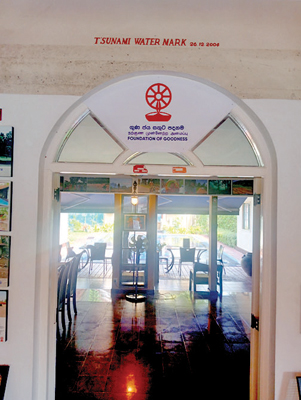
The tsunami watermark at the Foundation of Goodness
“I heard that my mother’s body was found but my eyes had shed so many tears I just couldn’t cry,” Champa said. She also learned that her grandparents had perished. I was depressed; I thought we could never recover from this tragic incident”, Champa said.
“When I was schooling, I always saw this homeless family living under the bridge in Ambalangoda. I wondered if we are like that family now”, she said
After the tsunami, Champa and her family lived together with a foreigner who rented a three-storey house further inland. There were three other families which included her brother’s family and her brother’s in-laws.
In the coming days, Champa organised with the villagers to provide relief from the Aluthwala temple. She recalled how Sri Lankans from around the country sent aid and assistance. Then the Seenigama villagers returned to the Seenigama Vihara which doubled as an aid centre. “We didn’t have time to sulk because we were busy rebuilding and helping families who had suffered immense loss”, she said.
We asked what Champa what her feelings were after a lapse of 20 years; during this time the country came out of a civil war, faced the Covid-19 pandemic, an economic collapse and a major shift in politics. She was cynical. “We saw people looting corpses; ripping rings off lifeless fingers and carrying away anything they could find. Then there were also those who gave up their own meals to feed those who were afflicted in the tragedy. The opportunists who got rich instantly were also destroyed instantly”, Champa said.
She said that it took nearly three years for things to stabilise and become normal once again. “Now we are stronger than ever”, Champa said.
Gamini Laddu is a janitor at the Foundation. He was watching a cricket match when the devastating waves struck. “I saw people being dragged out to the sea. I jumped in to save them since I’m a good swimmer. The heavy rocks in the breakwater were thrown inland just as pieces of styrofoam. I saw a toppled van and the male passengers who were outside crying for help. It was impossible to flip the waterlogged vehicle. There was a woman and a child inside but I couldn’t help them”, he lamented.
Gamini recalled how his little sister was trapped inside their ancestral home. I rescued her and took her to the temple. Our ancestral home was eventually destroyed”, he said.
Peraliya tsunami train wreck
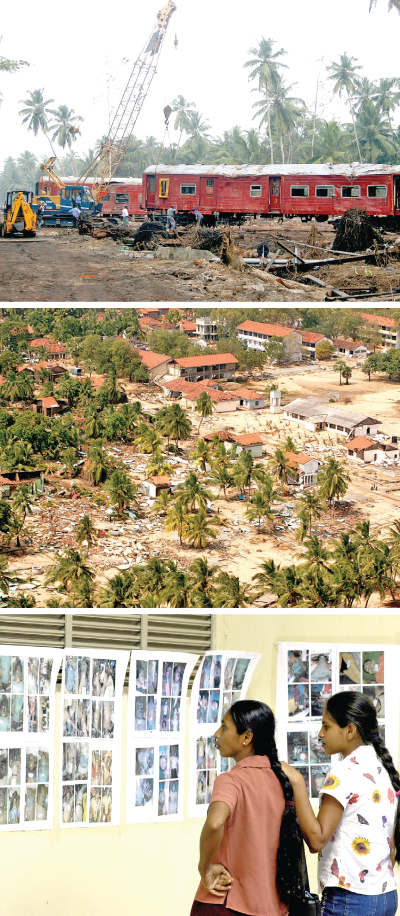 According to the death toll with over a 1,000 fatalities, the Peraliya tsunami train wreck is said to be the largest single rail disaster in world history. The crowded No 50, Matara Express toppled in Peraliya due to the force of the gushing waters of the fierce waves as it was plying towards the South.
According to the death toll with over a 1,000 fatalities, the Peraliya tsunami train wreck is said to be the largest single rail disaster in world history. The crowded No 50, Matara Express toppled in Peraliya due to the force of the gushing waters of the fierce waves as it was plying towards the South.
N.H. Samanmali, now a mother of two was on the train when the wave struck. She was just nine-years old in 2004. She was returning home after dancing in a perahera in Colombo and was accompanied by her two sisters, along with her dance teacher and ten other girls who made up the troupe.
“The train stopped and a crowd of people came screaming towards us. We had no idea what was happening, they said the sea had flowed inland. They climbed on board, while some came through and exited the other side. After 10 minutes there was a small wave at first which shook the train. Then the second wave struck,” she said.
It was obvious that Samanmali had experienced a huge childhood trauma. Most of her story was disjointed and I understood that many of the painful details have been suppressed in her mind. Samanmali said she regained consciousness when the water was receding but also remembers hanging on the luggage rack.
“Rescue teams broke the glass of the train windows and pulled us out and rushed us to the Telwatte temple. We crossed a makeshift bridge made up of desks and chairs from a classroom. That’s how I got to the hospital”.
She said that the Peraliya monument for tsunami victims still jostles her memory and brings untold sadness to her. Her dance teacher and a girl from the dance troupe perished in the waves, she said.
Shirley Koralage is a master diver and the proprietor of the Submarine Diving School in Unawatuna. Shirley’s father and younger brother perished while rescuing people when the deadly waves hit.
“I was close to the beach, about 20 metres away. I remember a huge white wave about four metres high entering the bay. It was actually beautiful at first sight but was a complete dark mess when it broke ashore. I couldn’t even see my hand in front of me. I was careful not to hit anything while the wave dragged me along and was mindful not to go down under. I was just trying to survive”.
As a diver Shirley said the speed of the wave was the real killer, not the size. “I saw the wave tossing a millstone over five metres. That’s how powerful it was”.
Shirley said he took 15 years to fully recover financially. The diving school lost its building along with all the equipment. What was left was the concrete foundation.
He introduced me to his son, now a master diver himself, who was just a one-year-old baby when tragedy struck.
“We were hit with regulations by the Coastal Conservation Department such as the 100-metre rule and 50-metre rule. Those who were financially sound built their hotels anyway. It was the poor who just couldn’t do anything and come out of the mess”, he said.
We asked if anyone benefited from the disaster and Shirley laughed and said, “Oh, the ‘golden waves’. Yes some benefited. I’m not pointing fingers at anyone but those who have been devastated have certain ideas and observers had different ones, if you know what I mean”.
He said they were living when the country went through a tsunami, war, a pandemic and an economic crisis. “We’ve seen it all. We’ve fought it all”, he said.
As a tsunami survivor his message is to never give up. “If you have a journey, stay on it”, he said.
Galle Fort
The Galle Fort was spared by the onslaught of the ferocious waves. Some say the centuries-old citadel is what saved the city from complete destruction. Tariq Nassim, the owner of Galle Fort’s Dairy King ice cream shop was in Colombo when he got the news of the devastating tsunami. Returning to Galle was a nightmare he said.
The road was littered with debris and the bridges were all down. “It was a dead road. It was ghost towns all the way down to Galle. We had to take an alternative route via Baddegama and the usual trip that took three hours took us nearly 10 hours”.
There were no electricity in Galle and the Fort got electricity only at 7 pm, he said. “The Fort was indirectly flooded from the old entrance is facing the harbour and the courthouse section went under seven feet of water”.
Tariq said the tsunami was a blessing in disguise because it opened the eyes of a lot of people. “But I don’t know how many people learned from it. You see people in the coastal belt are continuing to build in the same unsafe way. You can’t blame them too. People have to survive. What can I say? The memories remain; it’s sad and memories still linger”, he said.
Two decades later, the scars of the tsunami remain etched in the landscape and in the hearts of those who lived through it. Yet, the stories of survival and solidarity remind us of the enduring strength of the human spirit.
Sri Lanka has faced war, pandemics, and economic collapse since then, but as one survivor said, “We’ve seen it all. We’ve fought it all. And we are still here.”



